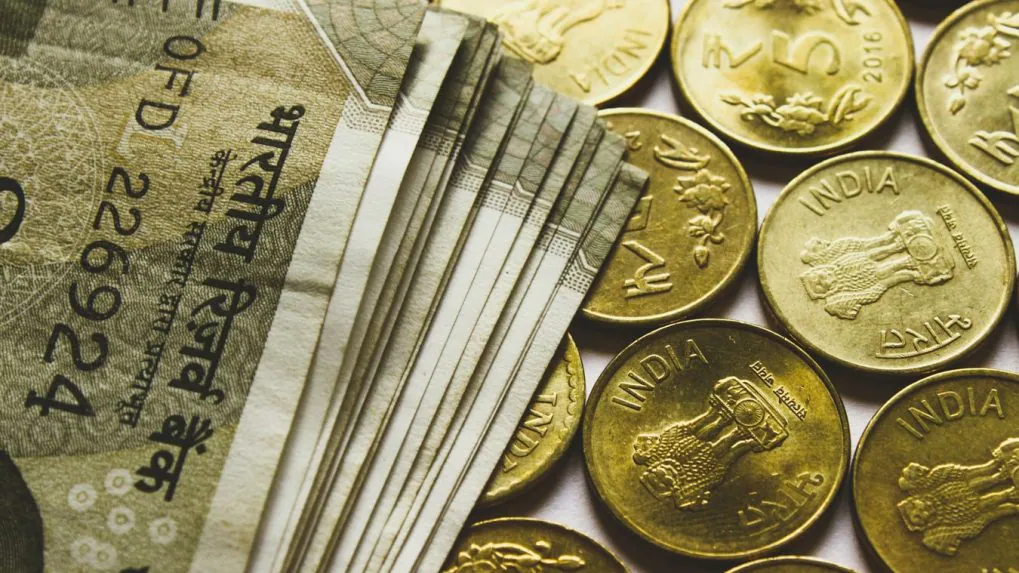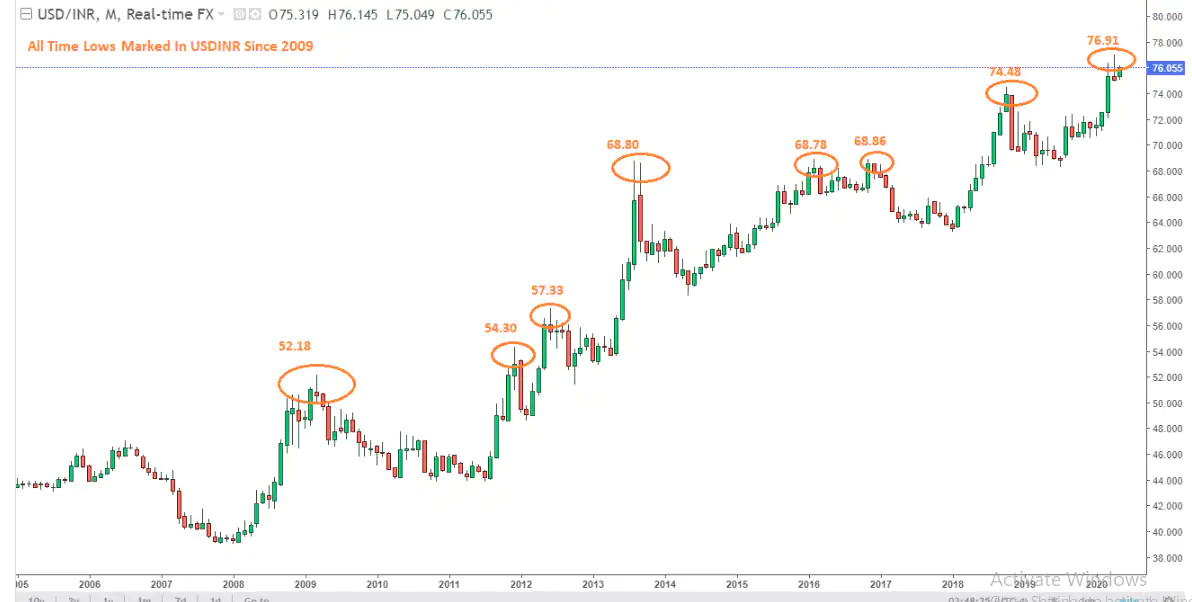- May 28, 2020
- Posted by: Amit Pabari
- Category: Currency

The rupee has been trading within its range of Rs 75-76.90 per dollar for over a month now. The momentum of the rupee is being pulled between the fresh global turmoil and domestic policy reforms. Currently, there are no dominating themes in the market to drive the trend in the rupee. However, the positive and negative developments that occurred over the course of time, the currency has still managed to sustain well within its range.
If seen historically, the rupee has taken quite some time to break its previous all-time low as shown in the chart below:
Since 2009, there have been seven occurrences of a sharp decline in rupee, and in all the cases, it has never broken its previous low for a long time as seen from the above table. As seen above, to break 52.18 and reach 54.30, it took 1,017 days. Recently, to break the previous all-time low of 74.48 and reach 76.91, it took just 559 days.
Also, whenever the rupee has gained from its all-time low for more than two weeks, the trend has remained intact for a while longer. Currently, the rupee has been trading above than its all-time low of 76.91 for 21 straight trading days, and is also holding above the long-term support of 74.50 for about 33 trading sessions.
The speculative activities in the local currency market have subdued and for now, the dollar-rupee trend is guided more by the demand and supply of dollars in the market. Off late, the trade volumes were low which helped the rupee to maintain a stable environment.
Does that mean rupee will retest or break its recent all-time low soon? Or it will not break its new range of 75.00-76.90 levels?
However, going forward, this range will be broken due to known or unknown factors. Let’s understand this by assessing the below factors:
Reasons why rupee may gain further and to trade below the upper end of the range (Rs 75 per dollar):
– Investors have turned optimistic with the opening of more economies which will soothe the impact of the economic loss due to lockdown
– Progress on vaccine development helps fuel the sentimental recovery in currencies and equities.
– FII and corporate inflows amid Jio stake sale and RIL rights issues are robust which can help limit the losses in the rupee.
– The huge forex reserves of over $487 billion would help the RBI to protect the rupee from any sharp depreciation arising out of negative GDP growth, rise in unemployment, fall in consumption, and other dull economic data.
– As a result of the slowing economy and contraction in the trade deficit, the external position of the country is comfortable with the current account surplus. Merchandise exports for April plunged 60.3 percent and imports fell 58.7 percent resulting in a trade deficit of $6.76 billion. The decline in gold imports by about 100 percent to $2.83 million in April has helped in narrowing the country’s trade deficit. However, Service estimates show net service exports of $6.93 billion leading to trade surplus of about $0.16 billion.
Reasons why rupee may fall further and break lower end (76.90) of the range:
– The Chinese foreign minister said that the US and China are nearing the ‘brink of new Cold war’. The relationship between the two has worsened dramatically as the US became one of the worst-hit countries by the pandemic. The world’s two biggest economies have clashed on a range of issues like trade, technology, and China’s latest move to tighten its grip on Hong Kong. This has led to the weakening of the Chinese Yuan near 7.15 offshore.
– Tensions are mounting between India and China after China has accused the Indian Army of crossing into its territory and of “blocking” its patrols and “attempting to unilaterally change the status” on the LAC.
– Lockdown had caused collateral damage to millions of daily wage earners, self-employed and people with jobs in small enterprises.
– The Indian economy has entered the COVID-19 recession with growth under pressure and MSMEs facing liquidity and solvency issues.
– The RBI’s policy statement described the inflation outlook as “highly uncertain” amid on-going supply chain disruption. This hints more policy rate cuts. The latest rate cut arouses the depreciation pressure on the Indian rupee as the outflows from the debt market might increase.
– The RBI is constantly buying foreign assets, signaling it is comfortable with a weak currency.
Assessing the above factors, it seems that the pair has equal reasons to break its range of 75.00-76.90 on upside or downside. However, if the pair breaks the range on the upside (76.90), we shall see a momentum of 1-1.5 rupee. But if the pair breaks the range on the downside (75.00), appreciation in the pair shall be limited up to 74.50, the same being a strong support and previous all-time high. Therefore we recommend remaining cautious while hedging and have a conservative approach rather than being adventurous.
Strategy for Exporters: Exporters shall sell 50-60 percent of their actual orders between 76.00-76.90. For remaining, they can maintain a strict stop-loss of 75.50 or costing whichever is high.
Strategy for Importers: Importers are suggested to keep a 1 to 1.5 months hedge cover and buy on dips between 74.80-75.30 levels.
-Amit Pabari is managing director of CR Forex Advisors. The views expressed are personal.
Leave a Reply
You must be logged in to post a comment.





